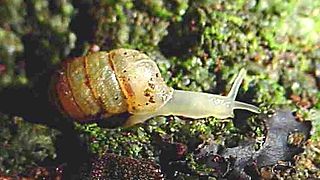In linguistics, a tenuis consonant is an obstruent that is voiceless, unaspirated and unglottalized.

Nepenthes tenuis is a tropical pitcher plant endemic to the Indonesian island of Sumatra. The species was first collected in 1957, from a remote mountain in the western part of the island. It remained undescribed until 1994, and was only rediscovered in the wild in 2002. Prior to this, N. tenuis was known solely from a single photograph and dried herbarium specimen.

The least pipistrelle is a species of vesper bat.

The thin mouse shrew is a species of mammal in the family Soricidae found in South Africa and possibly Mozambique.
Tayloria amaniensis is a species of air-breathing land snail, a terrestrial pulmonate gastropod mollusk in the family Streptaxidae. This species is endemic to Tanzania.
Tayloria is a genus of air-breathing land snails, terrestrial pulmonate gastropod mollusks in the family Streptaxidae.
Tayloria angustistriata is a species of air-breathing land snail, a terrestrial pulmonate gastropod mollusk in the family Streptaxidae. This species is endemic to Tanzania.

Streptaxidae is a family of carnivorous air-breathing land snails, terrestrial pulmonate gastropod mollusks in the clade Stylommatophora. Six Streptaxidae subfamilies are accepted in the 2005 taxonomy of the Gastropoda by Bouchet & Rocroi.
Peter Geoffrey Taylor (1926–2011) was a British botanist who worked at Royal Botanic Gardens, Kew throughout his career in botany. Taylor was born in 1926 and joined the staff of the herbarium at Kew in 1948. He published his first new species, Utricularia pentadactyla, in 1954. In 1973, Taylor was appointed curator of the orchid division of the herbarium and, according to Kew, "under his direction, orchid taxonomy was revitalised and its horticultural contacts strengthened."
Tayloria lingulata, commonly known as lingulate dung moss, tongue-leaved gland-moss, or marsh collar-moss, is a moss found in montane habitats in the Northern Hemisphere including Europe, Asia and North America.

Tayloria is a genus of mosses in the family Splachnaceae. It comprises 45 species, divided among 6 subgenera:
Tayloria is the scientific name for genera of organisms and may refer to:
The voiceless or more precisely tenuis dental click is a click consonant found primarily among the languages of southern Africa. The symbol in the International Phonetic Alphabet that represents this sound is ⟨ǀ⟩. The symbol in the International Phonetic Alphabet for a tenuis dental click with a velar rear articulation is ⟨k͡ǀ⟩ or ⟨k͜ǀ⟩, commonly abbreviated to ⟨kǀ⟩, ⟨ᵏǀ⟩ or simply ⟨ǀ⟩; a symbol abandoned by the IPA but still preferred by some linguists is ⟨k͡ʇ⟩ or ⟨k͜ʇ⟩, abbreviated ⟨kʇ⟩, ⟨ᵏʇ⟩ or just ⟨ʇ⟩. For a click with a uvular rear articulation, the equivalents are ⟨q͡ǀ, q͜ǀ, qǀ, 𐞥ǀ⟩ and ⟨q͡ʇ, q͜ʇ, qʇ, 𐞥ʇ⟩. Sometimes the accompanying letter comes after the click letter, e.g. ⟨ǀk⟩ or ⟨ǀᵏ⟩; this may be a simple orthographic choice, or it may imply a difference in the relative timing of the releases.
The voiceless or more precisely tenuis lateral click is a click consonant found primarily among the languages of southern Africa. The symbol in the International Phonetic Alphabet for a tenuis lateral click with a velar rear articulation is ⟨k͡ǁ⟩ or ⟨k͜ǁ⟩, commonly abbreviated to ⟨kǁ⟩, ⟨ᵏǁ⟩ or just ⟨ǁ⟩; a symbol abandoned by the IPA but still preferred by some linguists is ⟨k͡ʖ⟩ or ⟨k͜ʖ⟩, abbreviated ⟨kʖ⟩, ⟨ᵏʖ⟩ or just ⟨ʖ⟩. For a click with a uvular rear articulation, the equivalents are ⟨q͡ǁ, q͜ǁ, qǁ, 𐞥ǁ⟩ and ⟨q͡ʖ, q͜ʖ, qʖ, 𐞥ʖ⟩. Sometimes the accompanying letter comes after the click letter, e.g. ⟨ǁk⟩ or ⟨ǁᵏ⟩; this may be a simple orthographic choice, or it may imply a difference in the relative timing of the releases.
The voiceless or more precisely tenuis palatal click is a click consonant found primarily among the languages of southern Africa. The symbol in the International Phonetic Alphabet for a tenuis palatal click with a velar rear articulation is ⟨k͡ǂ⟩ or ⟨k͜ǂ⟩, commonly abbreviated to ⟨kǂ⟩, ⟨ᵏǂ⟩ or simply ⟨ǂ⟩. Linguists who prefer the old IPA letters use the analogous Beach convention of ⟨k͡𝼋⟩ or ⟨k͜𝼋⟩, abbreviated ⟨k𝼋⟩, ⟨ᵏ𝼋⟩ or just ⟨𝼋⟩. For a click with a uvular rear articulation, the equivalents are ⟨q͡ǂ, q͜ǂ, qǂ, 𐞥ǂ⟩ and ⟨q͡𝼋, q͜𝼋, q𝼋, 𐞥𝼋⟩. Sometimes the accompanying letter comes after the click letter, e.g. ⟨ǂk⟩ or ⟨ǂᵏ⟩; this may be a simple orthographic choice, or may imply a difference in the relative timing of the releases.
Tayloria nepalensis is an extant dung moss species found in Nepal. It was first described by Zennoske Iwatsuki and William Campbell Steere in 1975.
Tayloria acuminata, commonly known as acuminate dung moss and acuminate trumpet moss, is a bright-green dung moss species with violet radicles that age to a dark red. It is native to North America and Iceland, where it is found in bird cliffs in Hornstrandir. In Iceland it has the conservation status of a vulnerable species (VU).

Rupes Tenuis is a Martian north polar scarp. It is named after one of the classical albedo features on Mars. Its name was officially approved by IAU in 1988. It extends from latitude 74.94°N to 82.2°N and from longitude 242.12°E to 300.77°E. Its centre is located at latitude 81.6°N longitude 85.47°W. It marks the outer perimeter of Planum Boreum from longitude 242.12°E to 300.77°E, and it is formed by the eastern extension of the Olympia Cavi, a series of local troughs and depressions, which become longer and deeper as they merge to create the Rupes Tenuis scarp formation. The scarp is located to the west of Chasma Boreale, at the base of Planum Boreum, and its height varies from a few hundred metres to a maximum of approximately 1000 metres.






